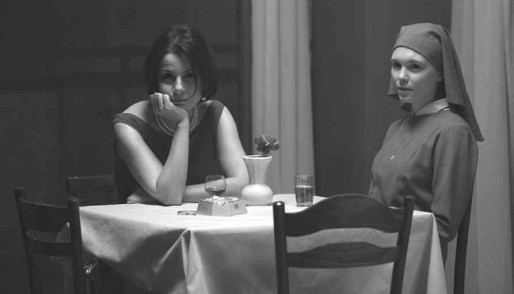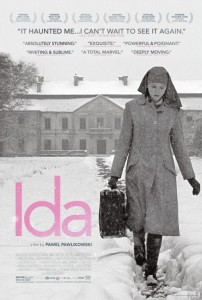An eighteen-year-old, preparing to take her final vows, must choose between the church and a family connection she never knew in Ida.
An orphaned infant girl, delivered to a Polish convent, grew up oblivious to her real identity, heritage and any ties to existing family. Raised by the sisters of the nunnery, her only guiding light is the path of Catholicism. Its strict dogma provided her the only foundation she’s ever known or trusts. Just before taking her final vows, Anna (Agata Trzebuchowska) learns two crucial things about her past. Her real name is Ida, and she has an aunt who is still alive and hopes to meet her. She sets off into an entirely foreign world to meet family whom she knows nothing about. To Ida’s view, Wanda (Agata Kulesza) is everything she isn’t. Lurid, loud and loose, she made her mark as a somewhat infamous Communist prosecutor, known during the war years for cold, harsh sentences — ones that included no shortage of church leaders.
Wanda, initially distant, slowly takes Ida under her wing, filling in the sordid details about her parents, their ultimate demise and how she found her way to the convent. As the pieces fall into place, the two share in their common bond and begin to grow closer. As they do, Wanda bears the weight of the past and her role in Ida’s abandonment. She feels responsible for Ida’s sheltered, seemingly suffocating existence. It left her knowing almost nothing of the real world and all its mysteries, which seem at once abhorrent and compelling to the young ingenue. The experience forces them both to question their own prior beliefs.
This Polish-made film, shot entirely on location, is presented in subdued black and white in a non-widescreen format that gives everything a very dated and dreary feel. The story takes place in 1962, just 17 years after the devastation of World War II, during which Poland endured the oppression of both the Nazis and the Soviets before finally falling under total Communist rule. The dismal surroundings are assisted by stark white snow that permeates everything with its isolating chill. It’s one of the rare cases where I felt that the use of black and white really enhanced the impact of the story without feeling like a cheap stunt.
The trouble for the film comes entirely with the plot. It’s a journey that only a fraction of the audience can enjoy. Many others will find it just as cold as the locations due to, in large part, its intentionally slow pace and muted undertones. When the film finally finished, I had to confront a question that no viewer should ever be left with — what was the point of it all?




